GemTek Technology U910109 Wireless USB Adapter User Manual WL 388F Manual
Gemtek Technology Co., Ltd. Wireless USB Adapter WL 388F Manual
Manual

WL-388F
11Mbps Wireless LAN Mini USB Adapter
User's Manual
2002/01/09
Gemtek Technology Co., Ltd.
2
Copyright statement
No part of this publication may be reproduced, stored in a retrieval system, or transmitted in any form
or by any means, whether electronic, mechanical, photocopying, recording, or otherwise without the
prior writing of the publisher.
Printed in Taiwan, 2002/01/09
3
Federal Communication Commission Interference Statement
This equipment has been tested and found to comply with the limits for a Class B digital device,
pursuant to Part 15 of the FCC Rules. These limits are designed to provide reasonable
protection against harmful interference in a residential installation. This equipment generates,
uses and can radiate radio frequency energy and, if not installed and used in accordance with
the instructions, may cause harmful interference to radio communications. However, there is
no guarantee that interference will not occur in a particular installation. If this equipment does
cause harmful interference to radio or television reception, which can be determined by turning
the equipment off and on, the user is encouraged to try to correct the interference by one of the
following measures:
- Reorient or relocate the receiving antenna.
- Increase the separation between the equipment and receiver.
- Connect the equipment into an outlet on a circuit different from that
to which the receiver is connected.
- Consult the dealer or an experienced radio/TV technician for help.
FCC Caution: To assure continued compliance, (example - use only shielded interface cables
when connecting to computer or peripheral devices). Any changes or modifications not
expressly approved by the party responsible for compliance could void the user's authority to
operate this equipment.
This device complies with Part 15 of the FCC Rules. Operation is subject to the
following two conditions: (1) This device may not cause harmful interference, and (2) this
device must accept any interference received, including interference that may cause
undesired operation.
IMPORTANT NOTE:
FCC RF Radiation Exposure Statement:
This equipment complies with FCC RF radiation exposure limits set forth for an uncontrolled
environment. This equipment should be installed and operated with a minimum distance of 20
centimeters between the radiator and your body.
This transmitter must not be co-located or operating in conjunction with any other antenna or
transmitter.
4
R&TTE Compliance Statement
This equipment complies with all the requirements of the DIRECTIVE 1999/5/EC OF THE
EUROPEAN PARLIAMENT AND THE COUNCIL of 9 March 1999 on radio equipment and
telecommunication terminal Equipment and the mutual recognition of their conformity (R&TTE).
The R&TTE Directive repeals and replaces in the directive 98/13/EEC (Telecommunications Terminal
Equipment and Satellite Earth Station Equipment) As of April 8, 2000 .
Safety
This equipment is designed with the utmost care for the safety of those who install and use it. However,
special attention must be paid to the dangers of electric shock and static electricity when working with
electrical equipment. All guidelines of this manual and of the computer manufacturer must therefore be
allowed at all times to ensure the safe use of the equipment.
EU Countries intended for use
The ETSI version of this device is intended for home and office use in Austria, Belgium, Denmark,
Finland, France (with Frequency channel restrictions), Germany, Greece, Ireland, Italy, Luxembourg,
The Netherlands, Portugal, Spain, Sweden and United Kingdom.
The ETSI version of this device is also authorized for use in EFTA member states Iceland,
Liechtenstein, Norway and Switzerland.
EU Countries Not intended for use
None.
Potential restrictive use
France: Only channels 10,11,12, and13
5
Contents
1. Contents …………………………………………………………………………………………..…...… ….5
2. Introduction……………………………………………………………………….…...………………… .….6
3. Wireless LAN Basics……………………………………………………………………….……...…………7
4. Installation forWindows…………….…..………………………………………………………..…….…….8
4.1 Installation Overview……………………………….……………………………………………..……9
4.2. Installation Procedure ……………………..……….……..……..………….….……………………10
4.3. Uninstallation Procedure…………………………………………..…………………………………17
5. Configuration.Utility …………………………………..………………….…………………………………18
6. Troubleshooting …….…………………………………………..…………………….…………………….27
6
2. Introduction
Thank you for purchasing our 11Mbps Wireless LAN Mini USB Adapter. This manual will assist you
with
the installation procedure.
The package you have received should contain the following items:
•=11Mbps Wireless LAN Mini USB Adapter.
•=User manual
•=Diskette containing Wireless LAN Management utility and drivers
Note: if anything is missing, please contact your vendor
The diskette contains the drivers and the program Configuration Utility that is used for managing the
11Mbps Wireless LAN Mini USB Adapter and establishing the wireless connection with your Local
Area Network.
7
3. Wireless LAN Basics
Wireless LAN (Local Area Networks) systems offer a great number of advantages over a traditional,
wired system. Wireless LANs (WLANs) are more flexible, easier to setup and manage and often more
cost effective than their wired equivalence.
Using radio frequency (RF) technology, WLANs transmit and receive data over the air, minimizing the
need for wired connections. Thus, WLANs combine data connectivity with user mobility, and, through
simplified configuration, enable movable LANs.
With wireless LANs, users can access shared information without looking for a place to plug in and
network managers can set up or augment networks without installing or moving wires. Wireless LANs
offer the following productivity, convenience and cost advantages over traditional wired networks:
•=Mobility - Wireless LAN systems can provide LAN users with access to real-time information
anywhere in their organization. This mobility supports productivity and service opportunities not
possible with wired networks.
•=Installation Speed and Simplicity - Installing a wireless LAN system can be fast and easy and can
eliminate the need to pull cable through walls and ceilings.
•=Installation Flexibility - Wireless technology allows the network to go where wires cannot go.
•=Reduced Cost-of-Ownership - While the initial investment required for wireless LAN hardware
might be higher than the cost of wired LAN hardware, overall installation expenses and life-cycle
costs will be significantly lower. Long-term cost benefits are greatest in dynamic environments
requiring frequent moves, adds, and changes.
•=Scalability - Wireless LAN systems can be configured in a variety of topologies to meet the needs
of specific applications and installations. Configurations are easily changed and range from peer-
to-peer networks suitable for a small number of users to full infrastructure networks of thousands
of users that allows roaming over a broad area.
8
4. Installation for Windows platform
The following section will assist you to in installing wireless LAN Adapter successfully. You will first
install software (driver) and then insert the 11Mbps Wireless LAN Mini USB Adapter, and finally set
the network properties to accommodate resource sharing and select the type of wireless network that
you wish to install. The Wireless LAN can easily be installed and used, without bothering to connect
cables for keeping your computer to use network resources, as in case of wired LAN.
9
4.1. Installation Overview
Here are some steps you will perform in establishing your wireless network connection:
Install the Access Point (AP) at first. AP is needed in case of Infrastructure network mode.
Install the software using the Installation Diskette or CD.
Install the 11Mbps Wireless LAN Mini USB Adapter.
Install the network protocol(s) required to communicate on your network. Most likely you will need
the TCP/IP protocol.
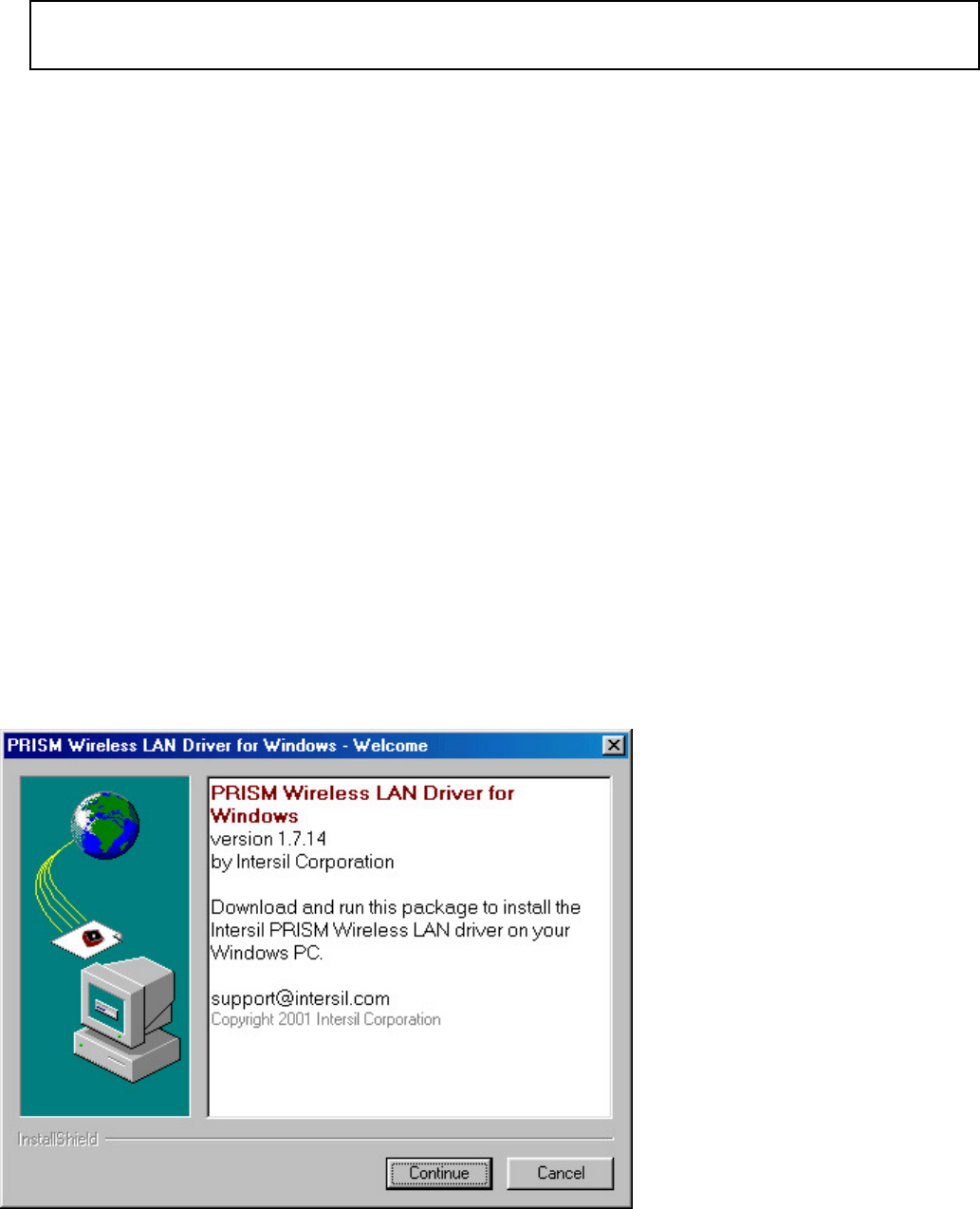
10
4.2. Installation Procedure
Please follow the following steps one by one in order to install successfully.
The PRISM WLAN Configuration Utility is installed simultaneously with the driver by executing the
PRISM for Windows.exe file. Installation procedures differ depending on whether this is an initial
installation or an upgrade. The following sections discuss these scenarios.
Note also that some versions of Microsoft Windows operating systems require administrator privileges
to install software. If this is the case for your operating system, be sure that you have such privileges
before executing the PRISM for Windows.exe file.
To upgrade an existing driver, it is not necessary to remove your PRISM card from your computer.
Simply run the PRISM for Windows.exe file to replace the existing driver with the latest version. After
the new driver is installed, you must restart the operating system (if the system was not restarted
during the installation procedure).
1. Insert the given Installation CD in the CD-ROM.
2. Select CD-ROM drives to locate driver files.
3. Find the software in the CD-ROM and run the program “ PRISM for Windows.exe file ” in order
to set up configuration utility & driver.
Follow the instruction and click Continue.
Note: Do not insert the WLAN USB adapter until you are asked to do so, failure of which may result in unsuccessful
installation of your 11Mbps Wireless LAN Mini USB Adapter
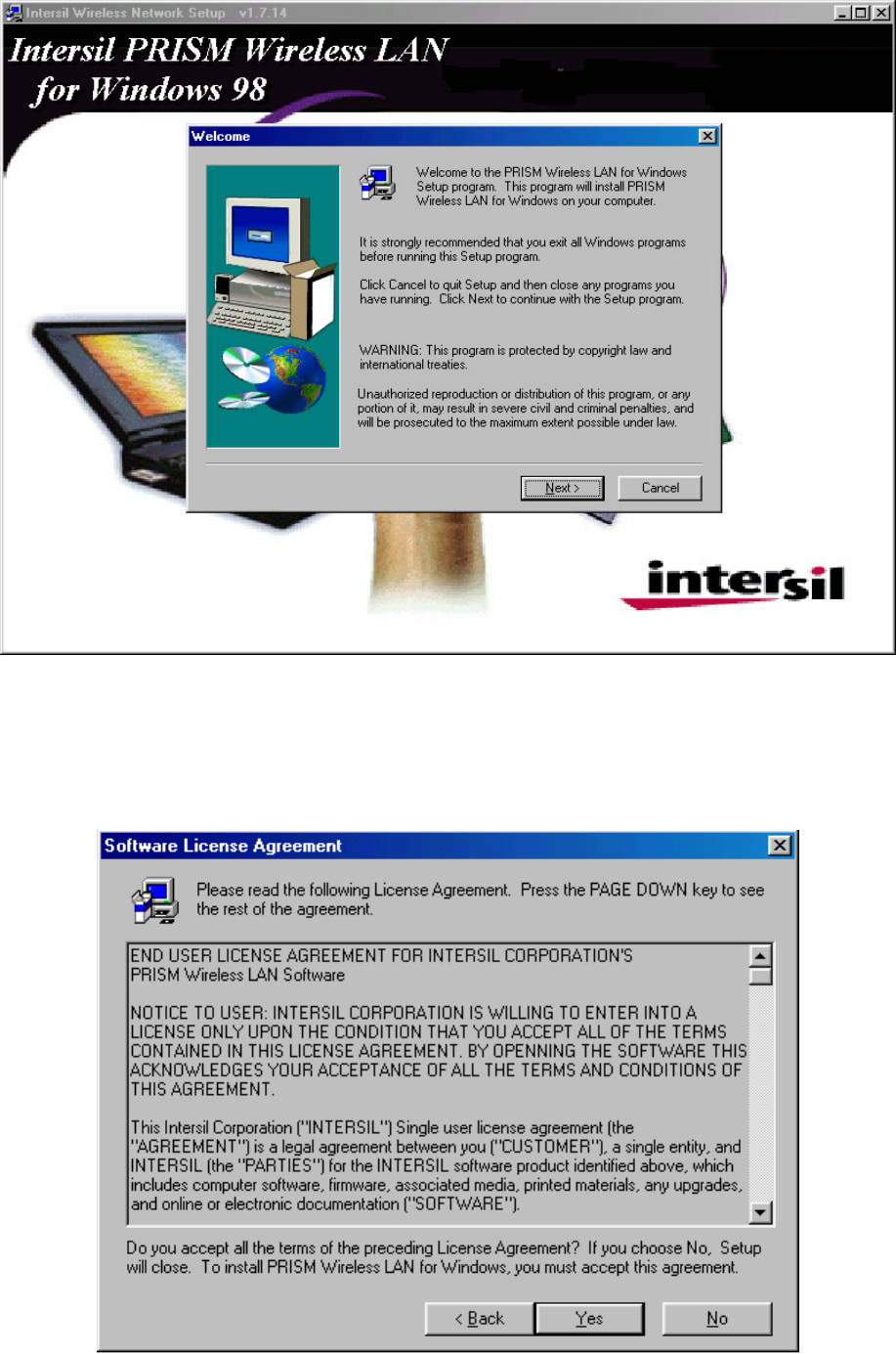
11
4. Accept the license agreement.
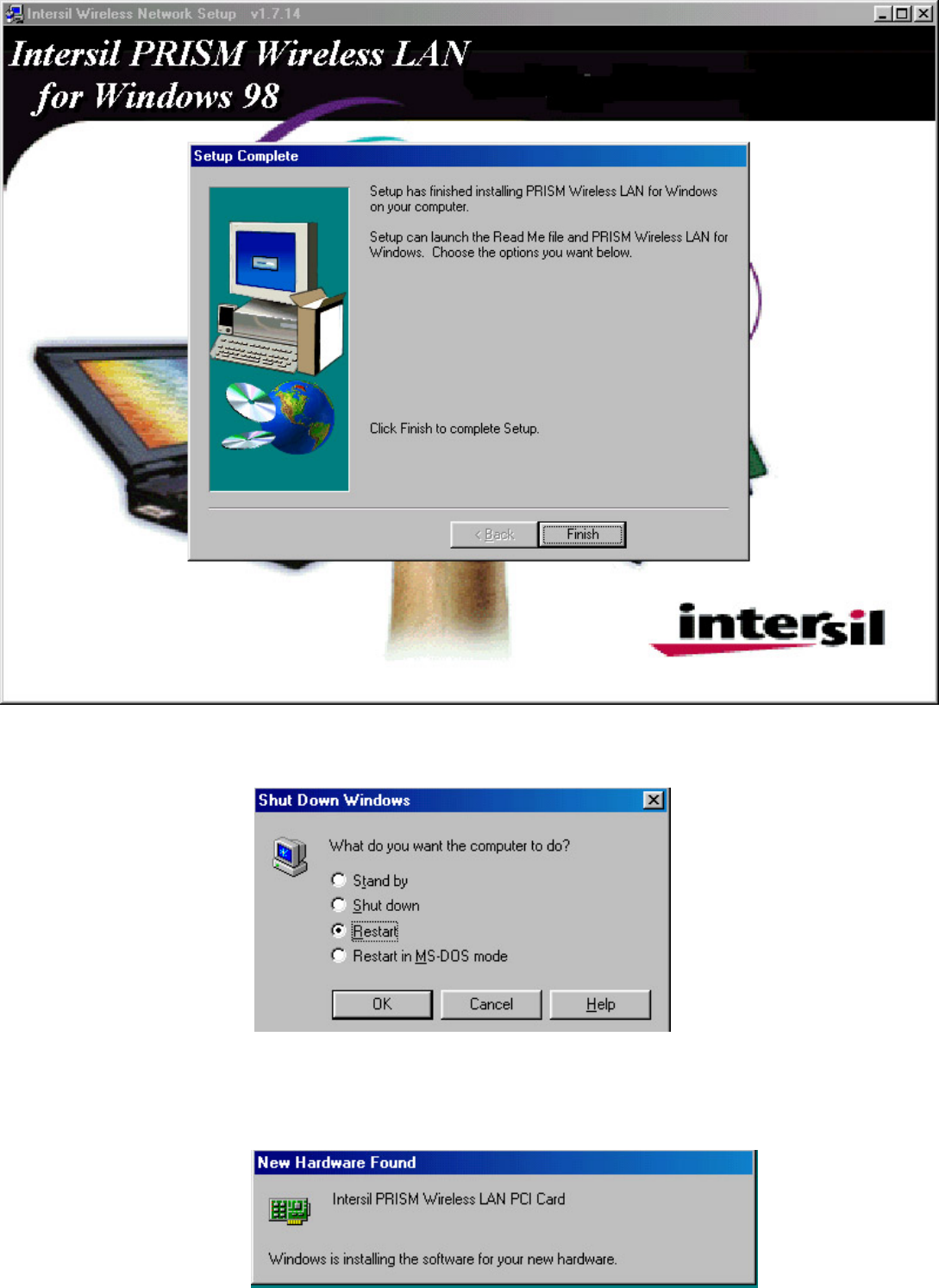
12
5. It takes a few seconds for copying the utility files and driver.
6. After setup complete, restart the computer.
7. Connect the 11Mbps Wireless LAN Mini USB Adapter to the computer, the system will detect new
hardware and auto install the driver.
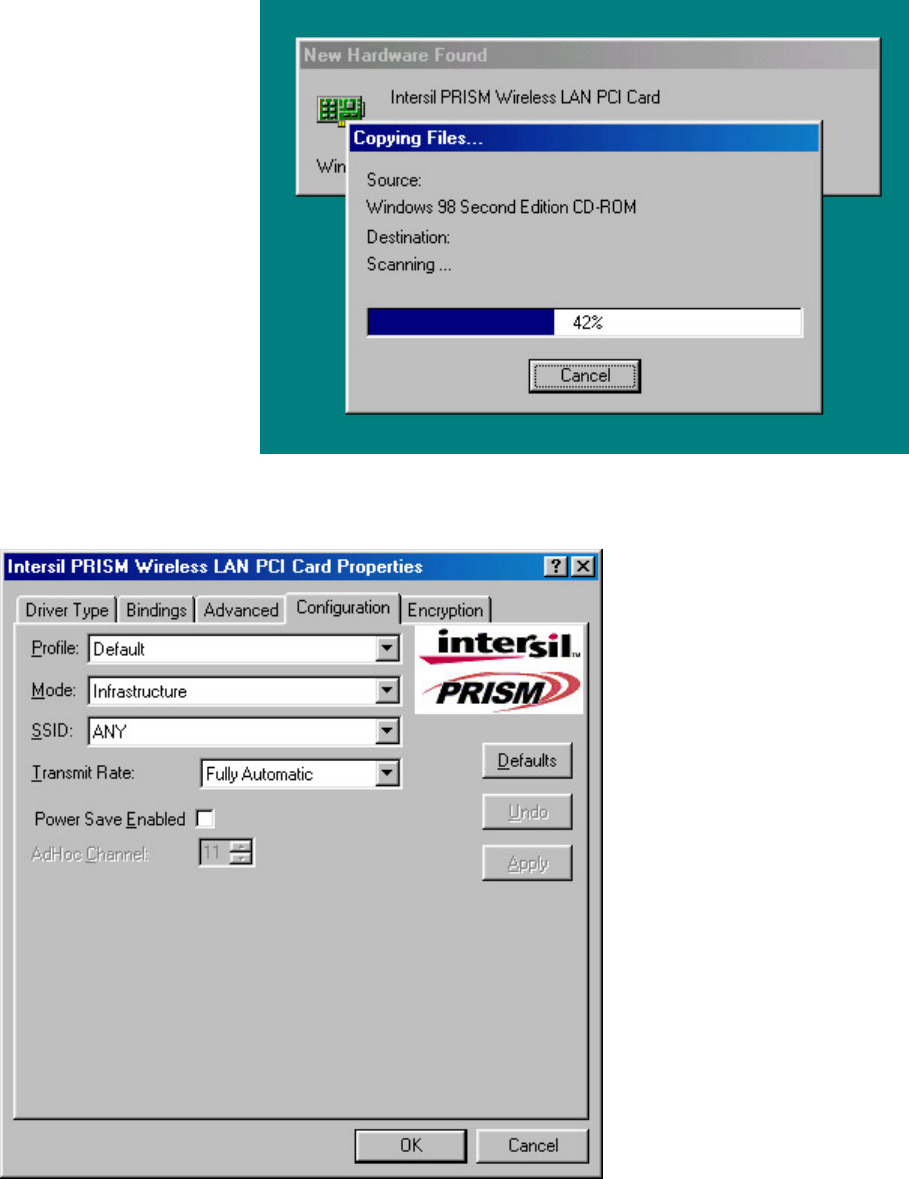
13
8. Once installation is complete, the utility will be pops up.
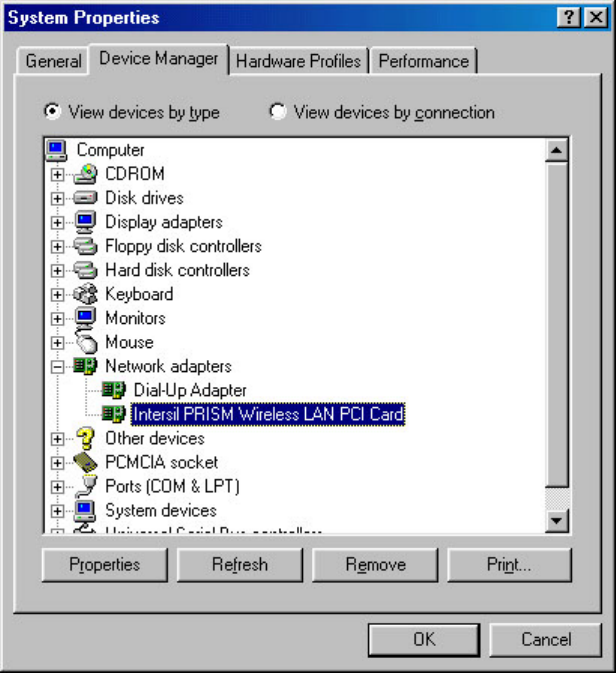
14
9. Click the right button of mouse on My Computer Properties Device Manager.
10. Right click on the Network Neighborhood using the mouse.
11. Select Properties from the pop up menu. The network box appears and you see three main tables:
Configuration, Identification, and Access Control.
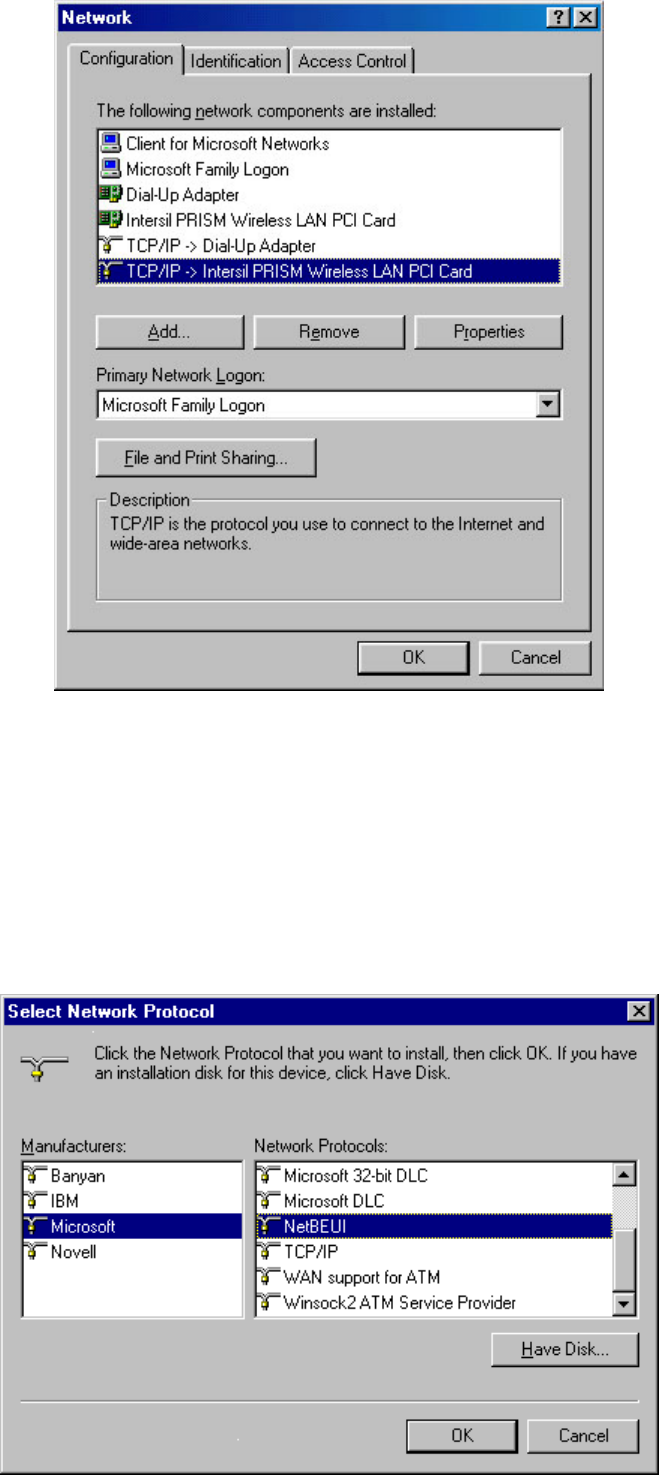
15
12. Click on the Configuration tab and then click on the Add button. Select Network Component Type
box appears. Click on the Protocol the click the Add button.
13. Select Network Protocols box appears. From the list of manufactures, click on Microsoft. From the
list of network protocols list, select NetBEUI, then click OK.
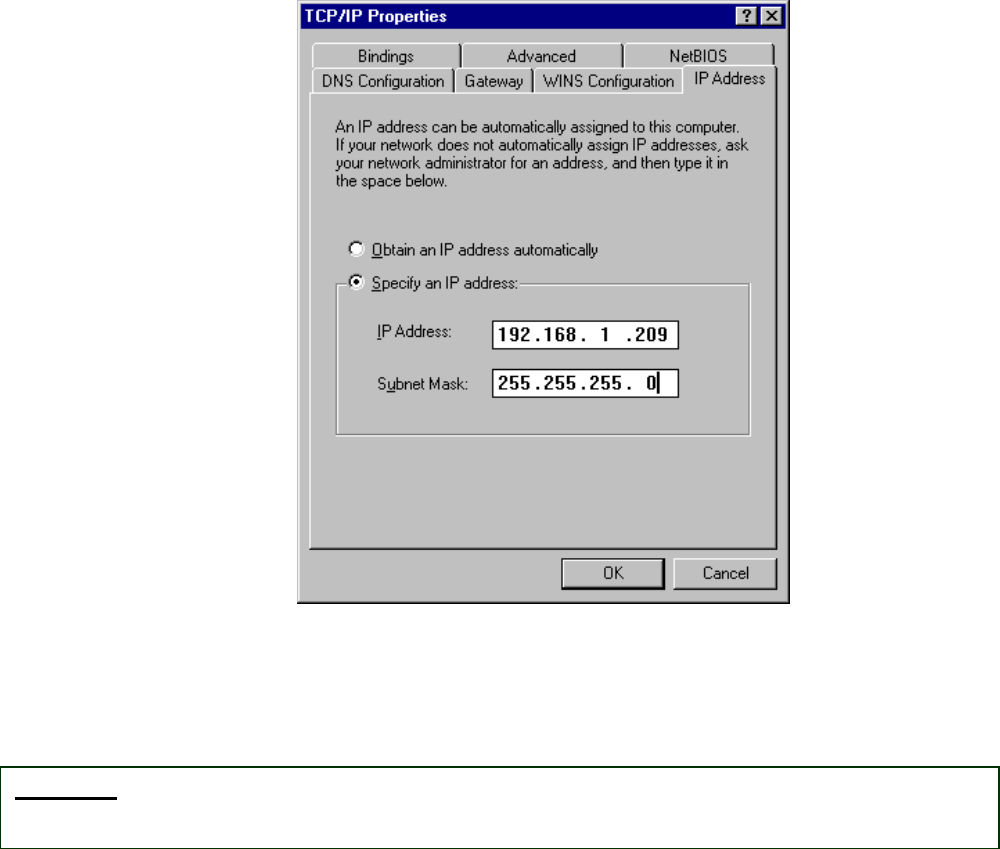
16
14. The NetBEUI protocol is now installed. After clicking on OK return back to Network Component
Type box.
15. Repeat the step 16 and 17 to add IPX/SPX protocol.
16. Repeat the step 16 and 17 to add TCP/IP protocol.
17. Click on the TCP/IP option for setting the IP address for your computer. You can select either Static
or DHCP setting. If you use the static IP setup then enter the IP value, Subnet masking , DNS,
Domain/ Workgroup name, and Gateway Address values. After setting these parameter
appropriately, click OK to return to Network Component Type and you can select the File and
Printer Sharing options as well as the Access to your computer like other users connected to that
network by setting the computer sharing options. Click on OK.
18. Screen message do want to restart your Computer will pop up. Select Yes. It will shut down your
laptop and will restart the system.
Important: Restart your computer to make the changes effective before you reinstall the
driver.
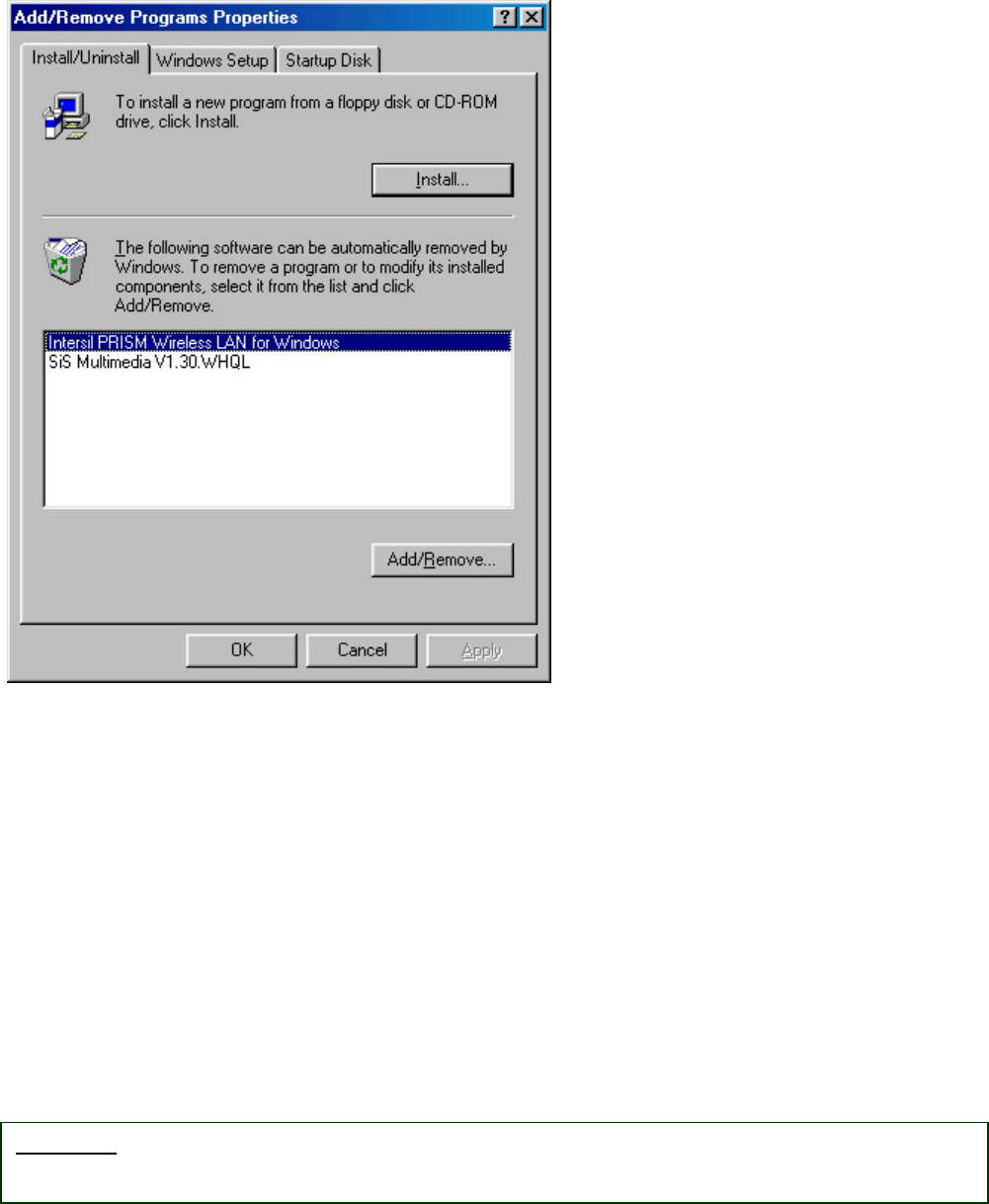
17
4.3. Uninstallation Procedure
If you want to uninstall the WLAN card under Win 98, please follow the steps as below:
1. Start Setting Control Panel Add / remove remove Intersil PRISM Wireless LAN for Windows,
click ‘ Add/Remove’ button.
2. Remove Inf. File : Click Start Program Windows Explorer Disk C Windows INF other
remove Intersil PRISM NIC
3. Romove sys.File: Click Start Program Windows Explorer Disk C Windows System
remove PRISMNDS.sys
Important: Restart your computer to make the changes effective before you reinstall the
driver.
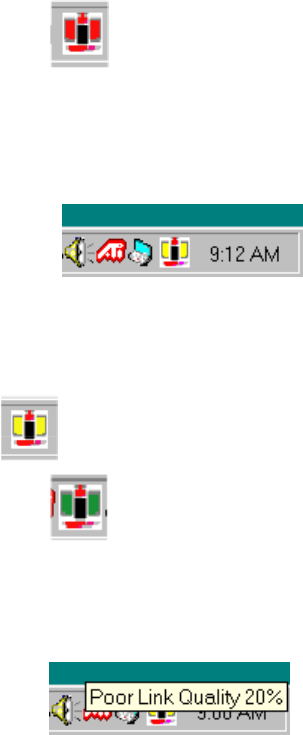
18
5. Configuration Utility
After the installation of the PRISM WLAN Configuration Utility, its icon appears in the System Tray in
the bottom right corner of your desktop.
The color behind the Intersil logo indicates the link status.
Red indicates no or very poor link quality.
Yellow indicates a usable but weak link.
Green indicates a good or excellent link.
You can also view the status of the link by placing the cursor over the Configuration Utility icon, as
shown in the following illustration. This illustration indicates that the PRISM WLAN Card is able to
communicate, but that the signal to the radio is weak.
The Configuration menu lets you specify the operating parameters for your PRISM WLAN Interface card. When
you first start the Configuration Utility, this menu is displayed. If another menu is displayed, you can display the
Configuration options by clicking on its tab in the Configuration Utility panel.
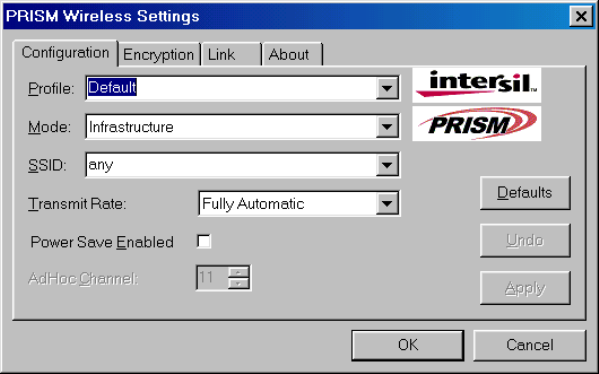
19
5.1 Configuration Tab
The Configuration menu lets you specify the operating parameters for your PRISM WLAN Interface
card. When you first start the Configuration Utility, this menu is displayed. If another menu is
displayed, you can display the Configuration options by clicking on its tab in the Configuration Utility
panel.
Setting the Profile
A profile is a named set of operating parameters for your PRISM WLAN Interface card. The Profile
field lets you set values for all parameters by selecting a previously defined profile. Click the down
arrow at the right of the Profile field to display the available profiles for your PRISM WLAN Interface
card.
You will always have at least one profile, named Default. Initially, this profile contains the parameters
configured at installation. You can modify this profile at any time after the installation. After changing
parameters, you can save them in the profile named in this field by clicking the Apply button in the
Configuration Utility panel.
You can also create additional profiles by typing a name in the Profile field. When you change the
name in the Profile field and then click the Apply button, the Configuration Utility uses the current
parameters for your card to create a separate profile. You can then switch between profiles by clicking
the down arrow at the right of the Profile field, selecting a profile from the drop-down list, and clicking
the Apply button.
The following example describes a situation in which you would want to create multiple profiles.
Suppose that you use the wireless LAN at your work, but you also have a network in your home (with
a wireless Access Point) for sharing an internet connection and a printer between several computers.
Suppose also that you have another office within your business which also has WLAN capability, but
which is configured differently than your main office.
In this situation, you can create a different profile for each of these three environments. Each profile
specifies the parameters used on a single network. Moving from one location to another, you only
need to apply the appropriate profile to be able to participate in the local network.
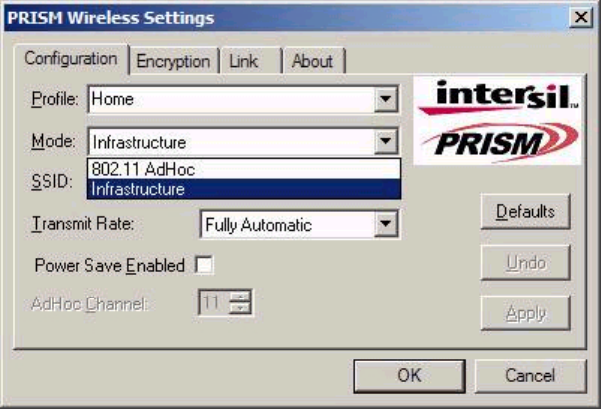
20
Setting the Mode
The PRISM WLAN Interface card can operate in one of two modes, which are specified in the Mode
field of the Configuration menu. Clicking the down arrow at the right of the Mode field displays the
available modes.
802.11 AdHoc Mode
IEEE 802.11, the standard on which the WLAN protocol is based, defines two modes to handle two
separate needs. The first, called AdHoc (or IBSS) mode, is used when two or more wirelessly-
enabled PCs wish to exchange data directly, without an Access Point. In this case the PCs can
establish an AdHoc network in which they are the only members and over which they can exchange
data. To exchange data, each computer participating in the AdHoc network must also specify the
same SSID and AdHoc Channel in this menu.
Infrastructure Mode
The second mode defined by the IEEE 802.11 standard is called infrastructure mode, and is the
primary application for WLAN operation. In this mode all data on the wireless network is directed to an
Access Point, which then routes the data to the appropriate wireless station. The Access Point may
also be configured to allow data to be bridged from the wireless network to wired networks.
To participate in a wireless LAN in infrastructure mode, every station and Access Point must specify
the same SSID. In infrastructure mode, all available channels are scanned for traffic, so there is no
need to specify a channel.
Setting the SSID
The SSID is the Service Set IDentifier used by Access Points and stations to identify a wireless LAN.
Your PRISM WLAN Interface card scans the available channels looking for an Access Point (in
infrastructure mode) or another station (in AdHoc mode) which has specified this same SSID. It then
attempts to associate with these Access Points or stations to form a wireless LAN.
To change the SSID, simply highlight it, type the new SSID, and click the Apply button.
In typical infrastructure applications a company will use a single SSID for all Access Points. If the
radio is scanning and cannot find a channel when an Access Point is known to be in range, verify that
the SSID is set correctly.
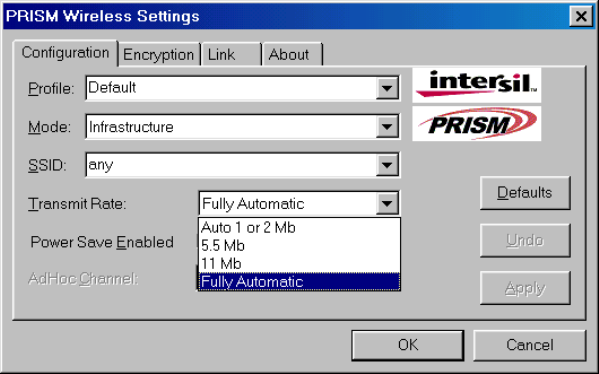
21
Setting the Transmit Rate
The Transmit Rate field specifies the rate at which the radio in your PRISM WLAN Interface card
transmits and receives data. You can view the available rates by clicking the down arrow at the right
of the Transmit Rate field.
The transmit rate can be set to:
•=Fully Automatic – your PRISM card chooses the highest available rate providing reliable
communications based on the capabilities of the Access Point or station with which it communicates
and on the received signal quality
•=Auto 1 or 2 Mb – allows only 1 and 2 Mb/s operation
•=5.5 Mb – allows only 5.5 Mb/s operation
•=11 Mb – allows only 11Mb/s operation
To change the Transmit Rate, click the down arrow at the right of the field, highlight the rate you want
to set, and click the Apply button.
Under most conditions, you should choose Fully Automatic as the transmit rate. In general, fixed rates
are used only in test environments.
Enabling Power Save Mode
The IEEE 802.11 standard provides a Power Save Mode. In this mode your PRISM card listens for a
beacon (a periodic frame which defines the network type and attributes) and determines the beacon
interval. Between beacons the card puts itself to sleep, enabling power savings. At the time of the
expected beacon the card wakes itself up and receives the beacon. The received beacon contains
information about whether the Access Point or station has buffered frames for the card. If frames are
available the card requests those frames until no more frames are available. The card then goes back
to sleep until the next beacon.
For Access Points that support power save mode and for stations equipped with WLAN cards,
enabling this mode can significantly reduce power consumption, which is particularly important if the
host computer is operating on battery power. However, be aware that power save mode also results
in lowered transmission and reception speed on the wireless LAN.
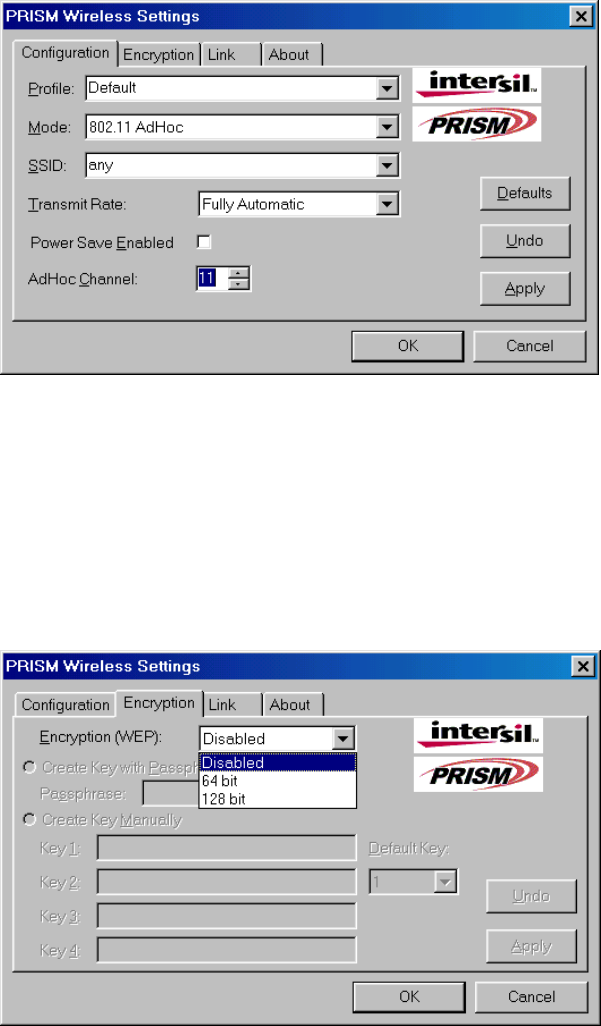
22
Selecting the Ad Hoc Channel
When communicating in AdHoc or Pseudo AdHoc mode, you must specify a channel on which
communications will take place. To specify a channel, click the up or down arrow at the right of the
AdHoc Channel field until the channel you want to set appears, and then click the Apply button.
This field is greyed in infrastructure mode because the channel is automatically selected by the
Access Point.
Encrption
The Encryption menu lets you enable encryption and set the encryption keys. To see the available
encryption methods, click the down arrow at the right of the Encryption {WEP} field.
There are two encryption methods available. The IEEE 802.11 specification defines Wired Equivalent
Privacy (WEP) using a 64-bit key. This capability was extended by the industry to allow a 128 bit key.
If you specify an encryption method, you will only be able to communicate with Access Points and
stations that use the same encryption method and keys.
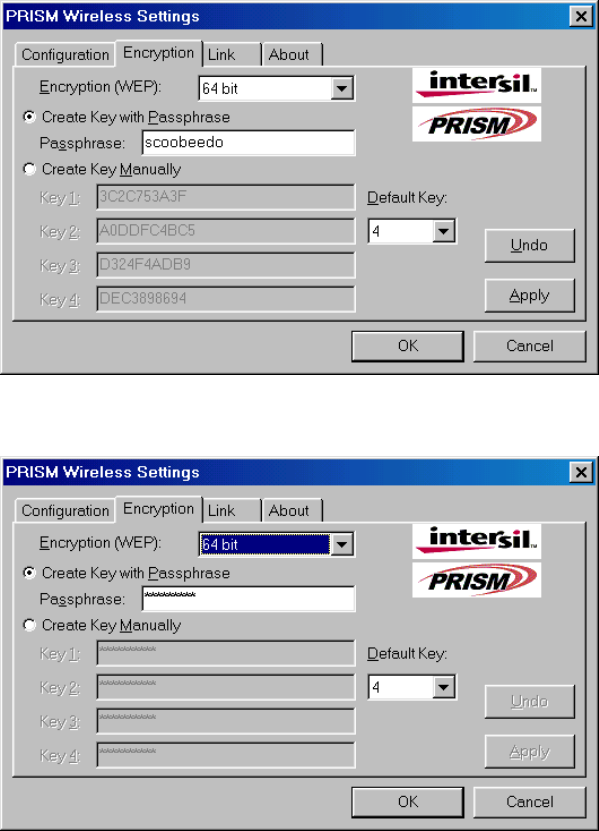
23
Disabling Encryption
To disable encryption, click the down arrow at the right of the Encryption field, select Disabled, and
click the Apply button.
Enabling Encryption
To enable encryption, click the down arrow at the right of the Encryption field, select either 64 bit or 128
bit, and click the Apply button. After enabling an encryption method, you must then specify encryption
keys, as described in the following sections.
Creating Encryption Keys Using a Passphrase
To create encryption keys using a passphrase, click the radio button next to Create Key with Passphrase
and type a character string in the Passphrase field. As you type, the Configuration Utility uses an
algorithm to generate four keys used for encryption.
When you finish typing your character string and click the Apply button, the Configuration Utility uses
asterisks to mask both your passphrase and the keys it generates.
Using a passphrase to generate the four keys makes it easy to set the same keys for all members of
your wireless LAN.
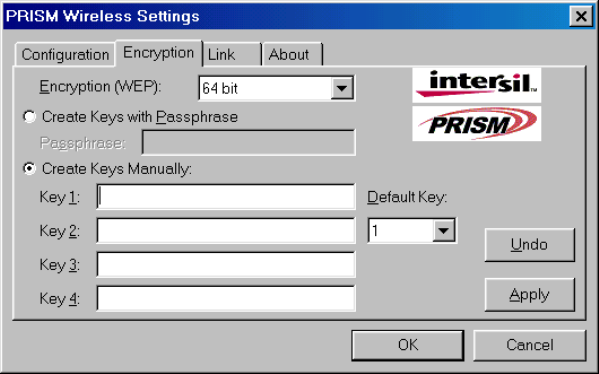
24
Creating Encryption Keys Manually
If you want, you can create encryption keys manually by clicking the radio button next to Create Key
Manually, as shown in the following illustration.
When you click this button, the cursor appears in the field for Key 1. For 64-bit encryption, you must
type exactly 10 hexadecimal digits in each of the four key fields; for 128-bit encryption, you must type
exactly 26 hexadecimal digits. You then click the Apply button to create your encryption keys. After
you click the Apply button, the Configuration Utility uses asterisks to mask your keys.
Default Key
The Default Key field lets you specify which of the four encryption keys you use to transmit data on
your wireless LAN. You can change the default key by clicking on the down arrow at the right of this
field, selecting the number of the key you want to use, and then clicking the Apply button. As long as
the Access Point or station with which you are communicating has the same key in the same position,
you can use any of the keys as the default.
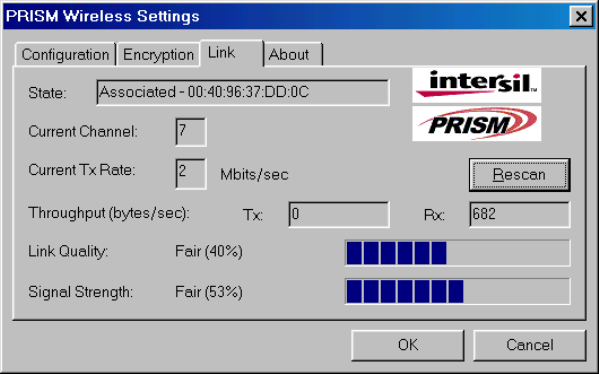
25
Link Tab
The Link menu provides information on the status of your communications with the wireless LAN.
The fields in this menu provide the following information:
•=State: shows the association state of your computer with the wireless LAN. When operating in
Infrastructure mode, this field shows the MAC address of the Access Point with which you are
communicating. When operating in AdHoc mode, this field shows the virtual MAC address used by
computers participating in the AdHoc network.
•=Current Channel: shows the channel on which the connection is made. In Infrastructure mode, this
number changes as the radio scans the available channels.
•=Current Tx Rate: shows the highest transmit rate of the current association.
•=Throughput: shows the short term transmit and receive throughput in bytes/second, and is
continuously updated.
•=Link Quality: is based on the quality of the received signal of the Access Point beacon.
•=Signal Strength: is based on the received signal strength measurement of the baseband processor of
the Beacon signal.
You can click the Rescan button to force the radio to rescan all available channels. If your link quality
or signal strength is poor, rescanning can be used to push the radio off a weak Access Point and
search for a better link with another Access Point.
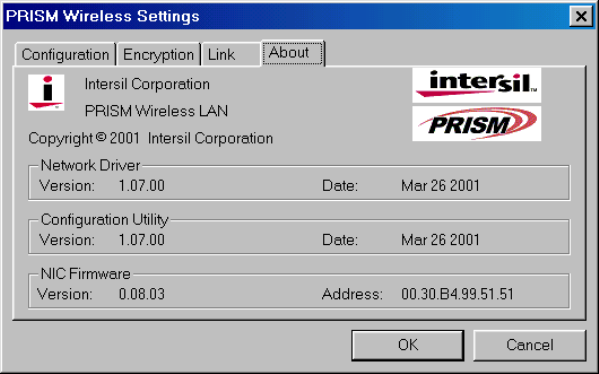
26
About Tab
The About menu provides information on the version of the Network Driver, the Configuration Utility,
and the firmware in the PRISM WLAN Interface card. In addition, this menu also provides the MAC
address of the PRISM card.
27
6. Troubleshooting
To make the installation of Wireless LAN 11Mbps Card more users friendly, we have suggested
following the installation steps one by one as listed in the section 4 and section 5. Still you encounter
some problems while installing the Wireless LAN 11Mbps Card or you want to confirm whether your
card is installed properly or not, we have listed the procedure for checking the various components
after you have installed the card. In first part of Troubleshooting, we have suggested the users to
check the various properties of the card to check the proper installation. In second section, we have
listed the various problems that you may encounter during the installation and have also listed the
possible solution. Check the first part to guess the probable reason of unsuccessful installation.
Procedure to Check the Various Properties of Card after Installation under Windows 98:
Please check the followings if you encounter some problem while installing the Mini-PCI card or your
Mini-PCI card is non-functional.
1. Click on the Control Panel and then on PC Card. Check whether it has PC card in one of the
sockets or not. If you find Wireless LAN Card in one of the sockets, it means the card is
detected properly. If you see the Yellow sign of Question-mark (?), the resources are conflicting.
2. Right click on My Computer and the select Properties. Select the Device Manager and click
on the Network Adapter. You will find Wireless LAN 11Mbps Card if it is installed
successfully. If you see the Yellow sign the resources are conflicting. Click on Mini-PCI Card
and then on Mini-PCI Card Service, you can see the status of Mini-PCI card. If there are yellow
sip either on adapter or Mini-PCI card, please check the followings.
1. Check if your Notebook supports 3.3V Card.
2. Check if your Notebook has a free IRQ. If not, make an IRQ free by assigning
the same IRQ to some devices, for example COM 1, COM 2 can be assigned same
IRQ values.
3. Check that you have inserted the right card and have installed the proper driver.
28
For the Card under Windows 2000:
Please check the followings if you encounter some problem while installing the Mini-PCI card or your
Mini-PCI card is non-functional.
1. Check the Windows 2000 Diagnostics. You should find out whether there is any conflict
in the resource allocation or the I/O address, IRQ allocations. If you find that the IRQ or
I/O addresses are already assigned to some other devices, you must change that value.
I/O address needs 40h byte length.
2. Click on the Control panel. Double click on the Mini-PCI Card, you will see Wireless LAN
Mini-PCI 11Mbps Card . Double clicking on that will show you the Card Information,
driver name and the driver file. You must confirm the name of the driver and the driver file
as "cw10" and "cw10.sys". If you do not find the names as we listed before, there are
some problems and the driver is not installed properly. Reinstall the driver.
Note: Check the PnP BIOS setup menu and select no in case of the Wireless LAN 11Mbps
Card installation.